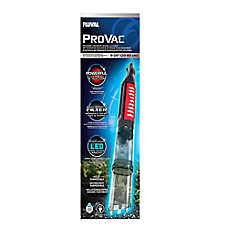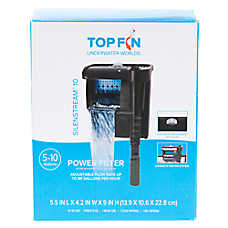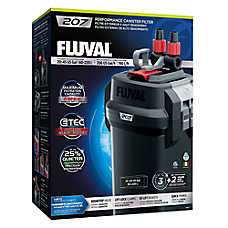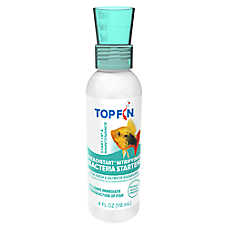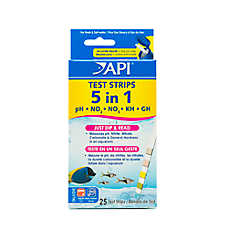Aquarium Maintenance Guide
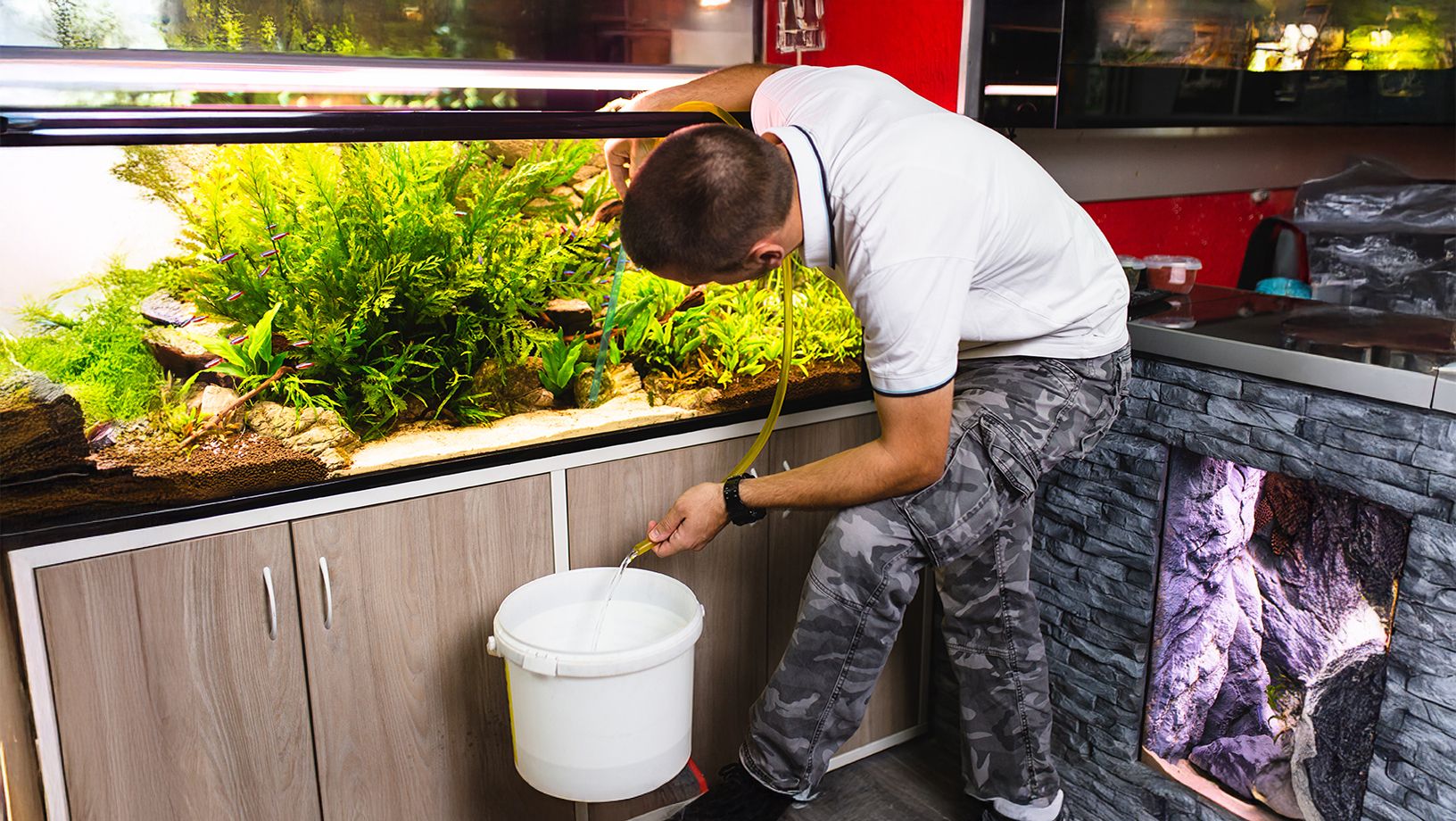
In this Article
Keeping Your Aquarium Healthy
Once you’ve got your aquarium set up and your water quality stable, now you move into maintaining your new aquarium. Your fish, plants, and invertebrates rely on you to keep their water clean and fresh - just like any other pet! The difference for fish is that they spend all of their time in the water, eating, drinking, and producing waste. That’s why clean, well-maintained water is essential.
The biggest tasks you face as a fish keeper are water changes and equipment maintenance. Water changes help maintain healthy water parameters while equipment maintenance ensures all parts are running smoothly.
Some aquariums are more labor intensive than others. Often aquariums with lots of live plants and relatively few fish need fewer water changes than heavily stocked tanks with few plants. Typically, you’ll want to have a routine water changing schedule every 1-2 weeks, changing 10-50% of your water volume each time.
Smaller tanks often need more maintenance than larger tanks due to the smaller volume of water in these systems. Large tanks have more water volume and more surfaces for beneficial bacteria. These larger tanks are more temperature stable and measures like Alkalinity and pH are less prone to disruption in these bigger tanks. Aquariums 10 gallons and up are going to be more stable than smaller systems. This can make maintenance easier.
Maintenance FAQ
Can I put my hands in my aquarium?
Yes, you can put your clean, freshly washed hands into your aquarium for maintenance. You’ll want to remove all lotions and soaps from your hands before you do. If you have any open wounds on your hands, use gloves or avoid placing your hands in the water. Always wash your hands well after performing maintenance in your aquarium.
What is a water change?
A water change is pretty much what it sounds like. You will remove water from your aquarium and replace it with dechlorinated tap water. Using a siphon to remove the water makes this much easier. The siphon end can be placed in a bucket, or some siphons are long enough to run directly to a sink or outdoors.
Why should I do a water change?
This is a good question and there are a variety of reasons. The first is to maintain nitrate within safe levels. Although nitrate is the safest waste breakdown product, it is still harmful to fish if allowed to accumulate. Experienced keepers can manage nitrate by balancing live plants and fish in a closely monitored system. However, for the majority of hobbyists, routine water changes are an important part of keeping healthy, happy fish.
How much water do I change?
This depends on how heavily stocked your tank is and how often you water change. A tank with relatively few fish may only need 10% removed and refilled every 2 weeks. However, a tank with a lot of fish in a relatively small space may need 50% of its water changed weekly to maintain ideal parameters. In general, a safe range is 20-30% weekly.
What equipment do I need?
The most essential tools are a gravel vacuum and a bucket. A gravel vacuum is a plastic tube connected to a flexible hose, which allows you to remove water and debris from the substrate.. You can direct the hose into a bucket, sink or outdoors if the tubing is long enough. Additional helpful equipment includes an algae scraper, algae removing pads, an old toothbrush, and towels to catch any splashes during maintenance.
How do I add water back?
First, check the temperature. A rapid temperature change can be extremely stressful or even fatal to fish. If your tap water is within 3°F, you can either use a bucket or connect your siphon directly to your tap. If using a bucket, add water conditioner or dechlorinator directly to the bucket. If using the tap directly, add enough water conditioner or dechlorinator for the full volume of the tank. While it can be tempting to skip adding a water conditioner or dechlorinator to your system, this can be a fatal mistake for your aquatic pets.
If your tap water is a more than 3°F warmer or colder, adjust the temperature prior to adding it to the aquarium. Make sure to use a water conditioner or dechlorinator with every water change. When you add water back, this is the time to add any alkalinity boosters, pH buffers, or fertilizers for your plants (if needed).
If you have a water softener that uses salt, avoid using this water for your fish tank as the salt can be unhealthy for routine use for your fish. If you need to reduce hardness in your aquarium, reverse osmosis or distilled water can be mixed with your tap water. Just like people can't thrive on distilled water alone, fish also need more than pure water - living exclusively in distilled water can deprive them of essential trace elements and minerals they need to stay healthy.
I heard bottom dwelling fish eat poop, so I don’t have to clean as much. Is that true?
No. While some fish do eat algae and invertebrates like shrimp and snails will eat the excess bacteria on surfaces, no fish eats poop. A good “clean up crew” for an aquarium includes algae eating fish, invertebrates, and plants to help absorb the waste breakdown products from your fish.
Should I do anything else?
Many hobbyists use this time to remove any algae or hard water buildup from the sides of the aquarium, trim any plants, rearrange decorations, and in general tidy up the aquarium. Often, water change day is also when filter maintenance is done. If your aquarium has a lid or hood, take the time to wife these down and wipe down the lights to reduce calcium or algae buildup.
What is filter maintenance?
Filter maintenance involves cleaning the filtration media, checking the moving parts to ensure everything is functioning properly, and reassembling the unit. You can read more about different types of filtration and detailed maintenance tips in the section below.
Anything else?
Typically, once the water change is complete, you’ll want to give your aquarium a quick wipe down since water often splashes and this keeps your aquarium sparkling and easy to enjoy!
Typical Aquarium Maintenance:
- Designate supplies (buckets, nets, rags, etc.) for aquarium use only. They should never come in contact with harsh chemicals.
- Do not remove fish for routine tank maintenance.
- Avoid replacing more than 50% of aquarium water at a time. If nitrate levels remain too high, an additional water change can be done the next day.
- Gravel vacuum at least once per month.
- Use an appropriately sized gravel vacuum for your aquarium. Follow the gravel vacuum manufacturer's recommendations when choosing the right size for your aquarium. Since vacuuming gravel also removes water from your aquarium, keep an eye on the water level to make sure that you don't remove more than 50% of the aquarium water.
- Watch for any fish, shrimp, or snails who may be caught in the suction.
- Filter cleaning should be done approximately once per month, but not during the gravel cleaning as too much beneficial bacteria can be lost at once.
- Chemical filter media should be replaced about every 2-4 weeks. Follow the manufacturer’s instructions.
- Mechanical filter media should be replaced at the frequency recommended by the manufacturer. However, sponges can usually be easily cleaned and reused for longer periods of time. Clean them in a bucket filled with aquarium water to prevent the loss of beneficial bacteria living on the sponge.
- Biological filter media should not be replaced. When doing filter maintenance, it should be placed in the aquarium or a bucket filled with aquarium water to prevent the loss of beneficial bacteria. It should never be cleaned in tap water and should not be allowed to dry out.
- Scrub algae as needed using a tool or pad designed for scrubbing algae. Use caution with sharp tools in acrylic tanks as they can easily scratch your tank. Algae can be unsightly, but it is good for the water quality as it reduces nitrates.
- If you have live plants, trim any excessive growth or dying leaves. Add any fertilizers on a schedule.
- Wipe down the exterior of the aquarium and clean any external parts like lids or lights.
Let’s Talk Filtration
Aquarium filtration is one of the most important pieces in the fish hobby. Many options exist for filtration from relatively simple and inexpensive sponge filters for tanks under 40 gallons to more complex filters designed to handle larger fish and more waste like canister filters. All aquariums benefit from having multiple filtration types.
Each filter relies on different “medias”. Media refers to the products within the filter that provide various benefits listed below. We’ll discuss the types of filters for your system after the types of media.
Three forms of filtration media:
- Mechanical filtration removes particles from the water by passing it through media such as sponges, floss, or pads (in larger systems and ponds: sand, screens, plastic beads or balls). Using these individually or layered with other forms of mechanical filtration help remove solid waste or debris from the water by physically collecting or trapping it within the media.
- Mechanical filtration should be cleaned regularly with either dechlorinated water or the aquarium water removed during a water change and replaced as it degrades or loses its ability to remove particles.
- Biological filtration includes porous natural rock or gravel, porous ceramics, plastic media, or sponges. These items allow for increased surface area for the beneficial bacteria to live and reproduce on, which means a more stable tank.
- Biological filtration should be carefully rinsed with either dechlorinated water or the aquarium water removed during a water change.
- Biological filtration is typically long-lasting and should be replaced only a little at a time. Replacing all of this filtration media at once means that your aquarium may not have enough beneficial bacteria to convert waste and may result in you needing to cycle the system again.
- Chemical filtration involves media such as activated carbon, zeolite (clay that absorbs ammonia), or resins. Depending on the type of media, they can have an ionic charge or adsorptive properties to remove chemicals, heavy metals, and toxins from the water.
- Chemical filtration typically needs to be replaced every 2- 4 weeks.
How do I choose a filter?
Our friendly associates are a great resource! Filter type depends on your tank size, the fish in the tank, and stocking density of your system.
Some common filter types:
- Sponge filter: These are great in tanks under 40 gallons. These provide mechanical and biological filtration through the sponge and the air pump. During a water change, squeeze these a few times in the aquarium water you’ve removed during the water change every month.
- Hang-On-The-Back or HOB: These are a classic filter for a reason! These filters are easy to clean, easy to modify the media in, and effective. Typically, these have a lid that allows you access to the media in the filter making it easy to clean when you clean your aquarium. These do have moving parts and cleaning the impeller regularly helps keep the filter flowing and lasting longer. These are great for medium sized tanks, 10-75 gallons. Maintenance of these filters should be done monthly.
- External Canister Filters: Another popular option where the motor and filter media are outside of the tank and typically placed in the stand. These offer the most flexibility in terms of media choices. They tend to be more expensive but tend to be very reliable. These filters have a higher price point but sustain a high flow rate, making them ideal for large tanks (50+ gallons). Maintenance of these filters should be done monthly.
- Other Filters: Some other filter options include under gravel filtration which is a great biological filtration option, sumps which hold a lot of media and increase the volume of water in the system, and fluidized beds which hold biological filter media in moving water. These filters have their place in specific aquariums and researching your options is always encouraged!
Considerations for Choosing: One of the biggest factors in choosing your filter is the size of your aquarium. Filters come rated for flow in Gallons per Hour or gph. For HOB and Canister filters, you want the filter to turn over the full volume of your aquarium 4 to 6 times per hour. So, for a 50-gallon aquarium, you would want a filter rated for 80 to 120gph. Filter flows are rated with a clean, empty filter and often the filter runs below its maximum flow. When in doubt, choose a filter with higher flow. Most filters come with the ability to reduce your flow if needed.
The Nitrogen Cycle
Healthy aquariums rely on the Nitrogen Cycle, the process that allows beneficial bacteria to consume and detoxify waste products into less harmful forms that can be removed with regular maintenance and water changes. The beneficial bacteria grow on every surface in the aquarium, including the gravel, decorations and filter media. These helpful bacteria break down unhealthy fish byproducts (ammonia and nitrite) and convert them into nitrate through a process called nitrification.
Nitrate levels are maintained with routine water changes. Live plants will also help reduce nitrate levels by using ammonia to grow and flourish within your aquarium. Unfortunately, while products exist to help reduce nitrate, the only effective ways to remove nitrate are water changes and plants. Some very heavily planted tanks that are lightly stocked with fish can be maintained without water changes, but these tanks are typically kept by experienced hobbyists.
Maintaining a Beautiful Underwater World
Each aquarium is different and your choice in tank, substrate, plants, decorations, and fish is infinitely flexible. Aquariums can also change with time, evolving with your growth in the hobby.
Maintaining a clean and clear aquarium means you can sit back and watch your tank, whether you have stately and elegant angelfish, playful bettas, cichlids with big personalities, or industrious shrimp.
As you progress, you may find a love for a specific type of fish with more complex requirements and more labor-intensive maintenance. Or you may decide that a low maintenance system better suits your lifestyle. No matter your preference, there’s an aquarium experience that’s right for everyone!
When should I test my water quality?
- Fish are sluggish, near the bottom of the tank
- Fish are at the top, breaking the water to breathe
- Fish are not eating
- Sudden behavior changes in your fish
- Water is cloudy
- Water smells funny
PetSmart offers free water quality testing and one of our knowledgeable associates can help you get your system balanced.
When should I contact a veterinarian?
Contact an aquatic veterinarian if you notice the following signs:
- Unusual swimming pattern
- Thinness or decreased appetite
- Abdominal swelling
- Inflamed or discolored skin/fins
- Fins clamped to sides of body
- Scraping body on rocks (flashing)
- Visible signs of illness or recent fish loss
If your fish show any of the signs above, we recommend using the “Find a Fish Vet” tool at fishvets.org or wavma.org to locate a qualified aquatic veterinarian in your area.
SHOPPING CHECKLIST
What will I need for maintaining my aquarium?
- Water testing kit or strips
- Water conditioner/dechlorinator
- Beneficial bacteria starter
- Algae cleaning pad or scraper
- Gravel vacuum
- Bucket
- Nets
- If needed:
- Fertilizer
- Scissors to trim plants
- pH Buffers
- Alkalinity Booster
Ready to learn more?
This guide is a great starting place, but we encourage you to do more research on the individual species that you are keeping so that you can be as successful as possible with your aquarium!

